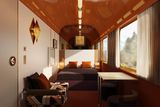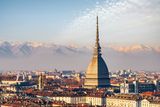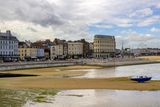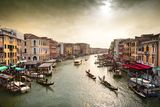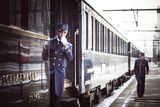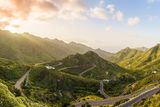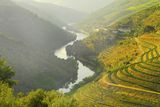Switzerland: A view from the ridge
Holidays in Europe
The magnificent Eiger, with its jagged teeth-like ridges, towers over all it surveys.
Christopher Jackson journeys from Lausanne to the jagged peaks of the Swiss Alps.
As the train winds its way up the steep Alpine slopes, toward Eigergletscher station, the great Eiger glacier comes into our view.
With its grey-flecked ice sheet, sticking out from its jagged teeth-like ridges, like a mocking tongue, it's as if the Eiger had always dared man to take it on. And that he did. An engineering marvel, the iconic Jungfrau railway is Europe's highest. Started in 1896, it took thousands of men, many of whom died, 16 years to finish it.
From Eigergletscher the trains ascend into the dark crevices of the mountain, toward the cavernous Jungfrauroch station, which at 3,454 metres is Europe's highest.
Jungfrauroch is not our final destination. Instead our train comes to a halt halfway inside the mountain. Our guide Maria beckons us out, and we clamber out into the darkness. We (a group from all corners, including China, Russia and Japan) hug the wall while the little red train struggles up the narrow track. There are two lithe men above us with helmets and sturdy boots. Kurt and Beat are local mountaineers and our guides for the next part of the tour; the ascent of the Eiger (well, part of it, at least).
Kurt and Beat give us a quick a crash course in how to use carabiners (the clips which tether you to the cliff face), which Beat assures us can take the weight of a small car, or so he says. After exchanging a few nervous glances with each other, we climb out of the darkness, toward daylight and onto the narrow ridge. Safely tethered (or so we hope) to the cliff face, we edge our way along, finding purchase on the craggy rocks. A sheer vertical, the cliff face disappears hundreds of metres above us. Behind us little pebbles tumble down the escarpment, accumulating in a great pile far below.
The view from the ridge is magnificent. The serene landscape of lush woodland and meadows stretches far to the horizon where the distant lakes glint a silvery hue. With us all assembled, Kurt demonstrates the correct climbing technique. Turns out it's all in the legs.
Kurt, with all the alacrity of a mountain lion, scrambles to a ridge about 20 metres above before abseiling down. Some of the group give it a try, most exercising caution and restraint. When it comes to me, I think I've it nailed. But it's not as simple as I thought. My old Nikes are worn at the soles and I can't get a grip. After a slightly embarrassing shove in the arse, I make up for it by heaving my way to the top. Determined to prove myself further, I spring off the face like a hyperactive tree frog. With just two jumps I'm down. But I'm not yet done. Egged on by Kurt, I jump back down the escarpment, onto the loose pebbles, until I'm right on the edge. Standing there, right on the precipice, I milk it, confident that I've saved face.
Before the Eiger, my visit to Switzerland was far more laid-back. It started three days earlier in Lausanne. Set on the shores of Lake Geneva, Lausanne is Switzerland's fourth largest city. Like Geneva and Zurich, it's a cosmopolitan city home to many international bodies, including the International Olympic Committee and the Olympic Museum (a must for any sports fan). And like Geneva and Zurich, it exudes poise and prosperity. Its wide avenues are lined by perfectly preserved period buildings, which include many museums, art galleries and theatres, while its expensive boutiques, jewellers and restaurants are busy with well-dressed customers, although few of these places quite exuded wealth as much as my hotel for the first two nights.
Overlooking Lake Geneva, the palatial baroque-style Beaux Rivage hotel is the embodiment of luxury, and has been so for 150 years. Its wood-panelled ballrooms, chequer-print marble corridors, crystal chandeliers and art Deco accents, recall the Grand Tour heyday of the 1900s, although the wealthy Oxbridge aristocrat types have been replaced by Russian, Chinese and Arab plutocrats.
The second day started near the lakeside town of Vevey. For 25 years, until his death, Charlie Chaplin lived in Manoir du Bon, a secluded mansion tucked away above the town. He's fondly remembered in Vevey. There's a life-size statue of Chaplin by the waterfront, while murals of him, several stories high, adorn apartment buildings on the town's outskirts, and his former home, following extensive renovations (which were still ongoing when we visited), has been turned into a museum.
Following our tour of the Chaplin museum, or rather the soon-to-be museum (it's now open), we headed down to Vevey. A quaint town full of references to its former residents (it was also once home to the famous philosopher Jean Jacques Rousseau), Vevey forms part of the Montreaux Riviera, otherwise known as the Swiss Riviera, which follows the north-east shore of Lake Geneva, centring on the iconic town of Montreaux.
After a tour of the town's streets and its bustling food market, we ended up at its marina, where the boat 'Vevey' awaited us. Built in 1907, the long, low-slung paddle ship carried us east, toward Castle Chillon, scattering ducks in its wake as the water, under the white of the sun, sparkled and fizzed like soda pop.
Perched on a rocky island and shadowed by steep verdant slopes, Castle Chillon commands the lake and its shoreline. Lying on one of Europe's most important trade routes, connecting France to Italy, it was much coveted by several powers. For centuries, the Bernese, Vauds and House of Savoy fought for control of it.
Accessed by a covered stone bridge, the carefully restored castle is replete with impenetrable sand-coloured walls, cobble stone courtyards, cone-topped turrets and an imposing keep from which the castle defenders could see their enemies from miles away. It's remarkable, both in its construction and its preservation, and it's easy to see why it's Switzerland's most visited historical monument.
On the third day, we left Lausanne for the final time, and, much to my chagrin, the Beaux Rivage (I'll always pine for when I had a TV in my bathroom mirror, and an electric awning above my lake-view balcony). Taking the train (which, as you'd expect in the land of the clock, is always on time), we travelled to the city of Thun. Overlooked by the 12th-century Thun Castle, the medieval city of Thun is an immaculate hodgepodge of Germanic-style buildings with steep red single roofs, set on narrow cobbled streets. From the castle, accessed by several hundred steps (not for the faint-hearted), we had the perfect panorama of Lake Thun and the Bernese Alps, including the peaks of the Niederhorn, Niesen and Jungfrau.
After a short boat ride, aboard another antique paddle boat, across the pristine glacial waters of Lake Thun, we boarded a vintage open-top bus to Interlaken. Driving on a winding lakeside road, we saw even more stunning scenery, this time lush woodland and flowery meadows. There will never be consensus on what is the most beautiful place in the world. Some may say it's Hawaii's rugged coast, others China's deep gorges. But show me someone who says that Switzerland's mountains, lakes and valleys aren't stunning, and I'll show you someone who knows nothing of beauty.
We arrived in the the town of Interlaken. A byword for winter sports, Interlaken is still busy in summer. Its central location and two train stations means it's a hub for walkers, hikers, skiers, mountaineers and daredevil face-jumpers and wing-suiters. Indeed, the next day, when we were clinging to Eiger's north face, we saw two wing-suiters jump from the cliff top above us. Hurtling through the air, they buzzed the treetops before opening their parachutes and landing in a nearby meadow. It's quite something to see one man fly, let alone two.
Following our final night, spent in the shadow of the great Jungfrau mountain, in the charming Hotel Belvedere in the small Alpine town of Grindelwald, we made for our final destination. At just under 3,000 metres, Schilthorn isn't the highest mountain of the Bernese Alps, far from it (Jungfrau is over 4,000 metres high). What it's noted for is being the setting of the 1969 James Bond film On Her Majesty's Secret Service, starring the forgettable George Lazenby (I mean, whoever thought an Australian car mechanic and model wouldn't make a great James Bond?). But while Lazenby failed to impress (he only played Bond once), Schilthorn did. We took three cable cars to the summit, passing over treetops, trails, log cabins and the occasional cow or two. The journey was almost as breathtaking as the destination, especially for one young English boy whose constant use of the word 'wow' rendered it utterly redundant.
Atop Schilthorn is a viewing platform, a James Bond Museum and, most enticingly of all, a revolving restaurant (which doubled as the base for the villainous Ernst Blofeld, played by the far more memorable Telly Savalas). From both the platform and the restaurant, we were presented with another panorama (as spectacular as that in Thun and on the Eiger) of snow-capped peaks, spine-like ridges and glistening lakes. It was a final confirmation, if needed, of Switzerland's awe-inspiring natural beauty.
Join the Irish Independent WhatsApp channel
Stay up to date with all the latest news
